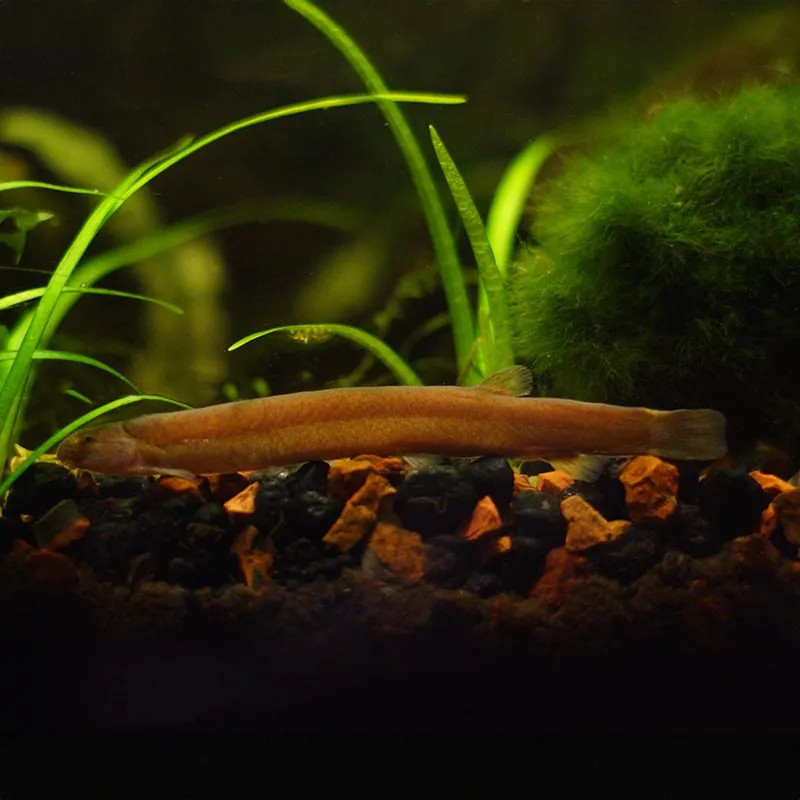Stocks Available
LOHACHATA BIOTA LOACH
SKU:118329
BOTIA ALMORHAE
1 INCH

Stock Available
Introduction: • Common Names: Black Kuhli Loach, Black Kuhlii Loach, or Coolie Loach • Natural Habitat: Native to freshwater environments in Southeast Asia, particularly in Indonesia and Malaysia, where they inhabit slow-moving streams, rivers, and flooded forests. Physical Characteristics: • Appearance: Characterized by a long, eel-like body with a dark brown to black coloration, featuring distinct orange or yellow stripes or bands along its length. Their bodies are elongated and laterally compressed. • Size: Typically reaches lengths of 4-5 inches (10-12 cm). • Lifespan: Can live up to 10 years or more with proper care. Habitat Requirements: • Tank Size: A minimum of 20 gallons is recommended for a small group of loaches, as they are social creatures. • Water Conditions: o Temperature: Prefers warmer water temperatures ranging from 75-82°F (24-28°C). o pH: Thrives in slightly acidic to neutral pH levels, typically between 6.0 and 7.5. • Aquascaping: Provide a well-planted tank with plenty of hiding spots, such as caves, driftwood, and dense vegetation, to mimic their natural habitat. Diet: • Primary Diet: Omnivorous; feeds on small invertebrates, detritus, and organic matter in the wild. • Supplemental Feeding: Offer high-quality sinking pellets, frozen or live foods like bloodworms and brine shrimp, as well as blanched vegetables. • Feeding Frequency: Feed small portions once or twice daily, ensuring they receive adequate nutrition without overfeeding. Compatibility: • Temperament: Generally peaceful and social; best kept in small groups of 4-6 individuals. • Suitable Tank Mates: Compatible with other peaceful community fish, such as tetras, rasboras, and small cichlids. • Incompatibilities: Avoid keeping with larger or aggressive species that may intimidate or harm the loaches. Care Level: • Difficulty: Considered easy to moderate in care; requires stable water conditions and a suitable diet to thrive. • Health Monitoring: Regularly check for signs of stress or disease, especially skin infections or parasites. Breeding: • Breeding in Captivity: Breeding is rare in home aquariums; specific breeding behavior is not well documented. • Spawning: They are egg layers, and spawning typically occurs in the presence of suitable tank conditions. Economic Considerations: • Market Demand: Popular among aquarium enthusiasts for their unique appearance and algae-eating capabilities. • Wholesale/Retail Pricing: Generally affordable and available in pet stores and aquarium shops. Sustainability and Conservation: • Wild Population: Currently not considered endangered; however, habitat destruction and pollution may pose threats. • Aquaculture Efforts: Mostly wild-caught, with limited success in captive breeding. • Regulations: Ensure compliance with local regulations regarding the trade and importation of freshwater fish. Conclusion: The Black Kuhli Loach is a charming addition to freshwater aquariums, known for its playful behavior and distinctive appearance. With appropriate care and a suitable environment, these loaches can thrive and provide ongoing enjoyment for aquarium enthusiasts. Introduction: • Common Names: Black Kuhli Loach, Black Kuhlii Loach, or Coolie Loach • Natural Habitat: Native to freshwater environments in Southeast Asia, particularly in Indonesia and Malaysia, where they inhabit slow-moving streams, rivers, and flooded forests. Physical Characteristics: • Appearance: Characterized by a long, eel-like body with a dark brown to black coloration, featuring distinct orange or yellow stripes or bands along its length. Their bodies are elongated and laterally compressed. • Size: Typically reaches lengths of 4-5 inches (10-12 cm). • Lifespan: Can live up to 10 years or more with proper care. Habitat Requirements: • Tank Size: A minimum of 20 gallons is recommended for a small group of loaches, as they are social creatures. • Water Conditions: o Temperature: Prefers warmer water temperatures ranging from 75-82°F (24-28°C). o pH: Thrives in slightly acidic to neutral pH levels, typically between 6.0 and 7.5. • Aquascaping: Provide a well-planted tank with plenty of hiding spots, such as caves, driftwood, and dense vegetation, to mimic their natural habitat. Diet: • Primary Diet: Omnivorous; feeds on small invertebrates, detritus, and organic matter in the wild. • Supplemental Feeding: Offer high-quality sinking pellets, frozen or live foods like bloodworms and brine shrimp, as well as blanched vegetables. • Feeding Frequency: Feed small portions once or twice daily, ensuring they receive adequate nutrition without overfeeding. Compatibility: • Temperament: Generally peaceful and social; best kept in small groups of 4-6 individuals. • Suitable Tank Mates: Compatible with other peaceful community fish, such as tetras, rasboras, and small cichlids. • Incompatibilities: Avoid keeping with larger or aggressive species that may intimidate or harm the loaches. Care Level: • Difficulty: Considered easy to moderate in care; requires stable water conditions and a suitable diet to thrive. • Health Monitoring: Regularly check for signs of stress or disease, especially skin infections or parasites. Breeding: • Breeding in Captivity: Breeding is rare in home aquariums; specific breeding behavior is not well documented. • Spawning: They are egg layers, and spawning typically occurs in the presence of suitable tank conditions. Economic Considerations: • Market Demand: Popular among aquarium enthusiasts for their unique appearance and algae-eating capabilities. • Wholesale/Retail Pricing: Generally affordable and available in pet stores and aquarium shops. Sustainability and Conservation: • Wild Population: Currently not considered endangered; however, habitat destruction and pollution may pose threats. • Aquaculture Efforts: Mostly wild-caught, with limited success in captive breeding. • Regulations: Ensure compliance with local regulations regarding the trade and importation of freshwater fish. Conclusion: The Black Kuhli Loach is a charming addition to freshwater aquariums, known for its playful behavior and distinctive appearance. With appropriate care and a suitable environment, these loaches can thrive and provide ongoing enjoyment for aquarium enthusiasts.
Data sheet
16 other products in the same category:
Customers who bought this product also bought: